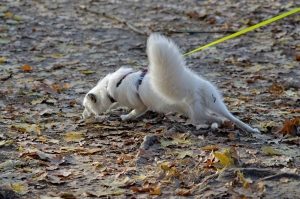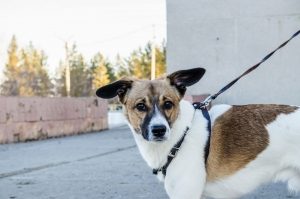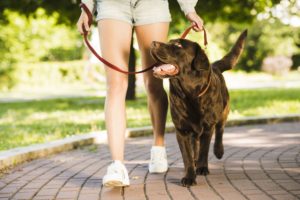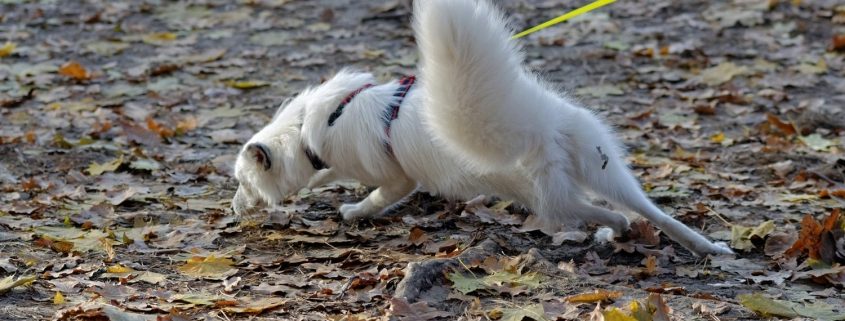Ask Crystal: Leash Pulling Pup
Welcome to “Ask Crystal,” where you can ask your pet behavior questions! You can submit your question for Crystal at the bottom of the page!

Dear Crystal,
I would like to take my dog out more now that the weather is warming up. The problem I am having is that she will not pay any attention to me. She is always at the end of her leash and looking at everything except me. I call her name but she doesn’t even acknowledge me. I get so frustrated with her that it isn’t any fun for me. How can I get my dog to pay attention to me?
Sincerely,
Feeling Ignored
Dear Feeling,
There is nothing more frustrating than feeling like you are talking to a brick wall. Hello, anyone there? I can understand where you are coming from. When I got my newly rescued adult dog, he looked like a kid at theme park just taking a walk in the park. He was pulling to get to the next attraction and looking everywhere but at me. Luckily, there is some hope and with some training at home, you can get a much better response even at a park.
All of the following training games and the majority of training should happen in a low distraction environment when first being trained. Slowly start to increase the level of distractions. Maybe you work in front of a busy window, then on your back deck or driveway and then front yard. After the dog has had a lot of practice in various places at home, start going to quiet places to practice in new areas. You can eventually build up to really distracting environments like a park or Main Street.
Attention is a really important skill for all dogs to have. We have to do some work to show dogs the value of checking in frequently with us. When we have a dog checking in every several seconds, we have a better connection and can better guide them through situations. There are a few different games to work on achieving attention from our dogs.
The Auto Check In teaches a dog to check in with us frequently. An important aspect of this training is that it is reinforcing an offered behavior. This is important because offered behaviors are cued by something in the environment not by a person constantly telling the dog what to do. Who wants all that work? I would much rather my dog offer appropriate behaviors at particular times than have to tell them what to do constantly. This cue teaches your dog when you are on leash, check in with me. To train this behavior, start inside the house and stand with your dog on leash. Stand neutrally, don’t cue the dog with eye contact, body language or words. The dog is eventually going to turn around and look at you. When they do, say “yes” and treat. Go back to standing neutrally and repeat.
The Name Game teaches dogs an automatic recall to their name. Personally, when I call my dog’s name it’s because I want them to come to me. I train this so that it becomes so conditioned that the dog doesn’t even think about it when I call her name. I practice this several times a day for the first several months. This will help ensure a reliable recall later in life. If your dog doesn’t seem to respond to their name at all, then start by standing in front of the dog and saying their name then “yes” and treat. You will start to notice their ears perk up when they hear their name and that means you can move on to the next step. Next, when the dog is turned away from you, say their name in a high pitch tone of voice and when the dog turns their head to look at you, say “yes” and treat the dog by your leg so that they have to come all the way to you to get it.
Eye contact is not a natural behavior for dogs. It is considered rude to stare. We can teach them it is something that we like. Studies also show that it is good for bonding because both parties release oxytocin when staring into each other’s eyes. I like to play a couple games from Leslie McDevitt’s Pattern Games called Up-Down and Ping Pong. These games teach dogs to focus and to be able to work around things that excite them or make them nervous. They are really easy to teach and a fun way to feed your dog dinner. Stand in front of your dog and wait for the dog to make eye contact. When they do, say “yes” and drop a treat in front of your feet. Dropping it on the ground primes the dog for another repetition. Ping Pong is the same concept but instead of dropping the treat in front of you, you drop it to the right and then to the left and back and forth. This is great for really energetic dogs. They get really into the pattern of it and rhythm which really gets them engaged.
 You can teach your dog a Watch Me cue as well. This might be a good option if the dog is turned away and you want to grab their attention. Start by having a lure in your hand and drawing a line up from the dog’s nose to your eye. “Yes” and treat when the dog makes eye contact. As the dog starts to get it, you can lose the lure and just use an empty hand. When the dog is responding to the hand signal at 80%, you can add the verbal signal of “watch me” right before you move your hand. Then start to build in duration by waiting longer and longer to mark the eye contact.
You can teach your dog a Watch Me cue as well. This might be a good option if the dog is turned away and you want to grab their attention. Start by having a lure in your hand and drawing a line up from the dog’s nose to your eye. “Yes” and treat when the dog makes eye contact. As the dog starts to get it, you can lose the lure and just use an empty hand. When the dog is responding to the hand signal at 80%, you can add the verbal signal of “watch me” right before you move your hand. Then start to build in duration by waiting longer and longer to mark the eye contact.
Always carry treats with you when you leave the house. These need to be super high value treats like chicken so you can compete with the world. The dog needs to learn that reinforcement is available at all times and places. If she offers any eye contact on her own, reinforce that heavily. Make a big deal, offer several treats in a row and throw a party with your voice. Try playing the Name Game and see if she responds.
 Practice your leash walking inside the house a lot. There are a lot of techniques to teach leash walking. The goal is to teach the dog where we want them to be and give them a reason to be there. We are looking for the dog to walk by our side, checking in every several seconds and for the leash to be slack. Start with your dog on leash. Get the dog into the position by your side. Say “yes” and treat several times in a row in the starting position. Next, take a small step forward, say “yes” and treat the dog for moving forward towards you. Slowly start to increase the number of steps in between treats. Then start to change direction and speed. Once the dog is mastering that inside the house, work in the backyard but start at the beginning. You can start in the same place as you were in the inside because the distraction level is much higher. You should be able to go through the steps pretty quickly though.
Practice your leash walking inside the house a lot. There are a lot of techniques to teach leash walking. The goal is to teach the dog where we want them to be and give them a reason to be there. We are looking for the dog to walk by our side, checking in every several seconds and for the leash to be slack. Start with your dog on leash. Get the dog into the position by your side. Say “yes” and treat several times in a row in the starting position. Next, take a small step forward, say “yes” and treat the dog for moving forward towards you. Slowly start to increase the number of steps in between treats. Then start to change direction and speed. Once the dog is mastering that inside the house, work in the backyard but start at the beginning. You can start in the same place as you were in the inside because the distraction level is much higher. You should be able to go through the steps pretty quickly though.
I would highly suggest buying a front connection harness which should help somewhat with the pulling while she is learning. There are a lot of different types of No Pull harnesses and what fits best is really going to depend on your dog’s body. A good pet boutique can help you fit the harness. They are supposed to fit in a certain way and not be saggy so it’s helpful to have someone that knows how they fit help you.
With some good practice at home, I have no doubt that your dog will get to a place where walks are more controlled and therefore more enjoyable. It takes work but it is so worth the effort. Happy training!
Until next time,
Crystal







